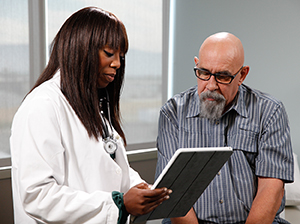Communicating More Clearly with Patients
There’s only so much you can do in a typical office visit. Use these tips to help you make the most of each patient encounter. They'll help you can get your message across in a clear, understandable way. You can apply most of these tips to both spoken and written communication with patients.

Keep content simple
-
English proficiency. Some patients may not understand English well. Provide them with language assistance services at all points of contact. This may include bilingual staff and interpreter services. For healthcare organizations receiving federal funds, providing these language services is mandated by the federal government. They must be provided to the patient for free, at all hours of operation. Don't use family members and strangers as interpreters or translators. Preserve your patients' confidentiality and comfort.
-
Key concepts. Highlight key concepts. And don’t be afraid to repeat them. Provide printed materials that support the concepts you want patients to learn. Such materials give consistent information. And patients and families can refer to them at home. Printed materials can also include links to online materials. Make sure online resources and smartphone apps work, are evidenced-based, and meet required literacy levels.
-
Interactivity. People learn best when they feel personally involved. If possible, let the patient show you a new skill they've learned. Perhaps your office can organize patient support groups. This allows patients to share their successes and challenges. For conditions such as chronic illnesses, think about having support groups for patients and for family members.
Use visuals
-
Convey key messages. Drawings, visuals, and anecdotes can reinforce key content you want a patient to remember. Illustrations help put abstract medical information into the context of a person’s real life.
Online Medical Reviewer:
Marianne Fraser MSN RN
Online Medical Reviewer:
Raymond Kent Turley BSN MSN RN
Online Medical Reviewer:
Robert Hurd MD
Date Last Reviewed:
1/1/2022
© 2000-2025 The StayWell Company, LLC. All rights reserved. This information is not intended as a substitute for professional medical care. Always follow your healthcare professional's instructions.